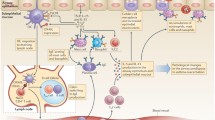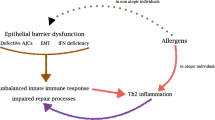Abstract
Th1 up-regulation seems to favour autoimmunity, while Th2 up-regulation seems to favour humoral immunity. Accordingly, subjects affected by atopic diseases (such as allergic respiratory diseases, ARDs) should be less prone to autoimmune diseases (such as multiple sclerosis, MS), and vice versa. The recent identification of Th17 cells, which seem to favour the development of both autoimmunity and allergy, led to the revision of the classic Th1/Th2 paradigm. We studied 200 MS patients and 200 controls to analyze the relationships between ARDs and MS. MS patients had less probability to suffer from ARDs (OR = 0.30, p < 0.001) and allergic rhinitis (OR = 0.25, p < 0.001), after adjusting for environmental factors. MS tended to be less severe when associated to ARDs. Our findings add some elements for the comprehension of immune mechanisms involved in MS pathogenesis and suggest to analyze other MS cohorts, in order to evaluate if MS patients affected by allergic diseases show particular clinical findings.
Similar content being viewed by others
References
Rudwaleit M, Andermann B, Alten R et al (2002) Atopic disorders in ankylosing spondylitis and rheumatoid arthritis. Ann Rheum Dis 61:968–974
Provenzano G, Donato G, Brai G, Rinaldi F (2002) Prevalence of allergic respiratory diseases in patients with RA. Ann Rheum Dis 61:281
Edwards LJ, Constantinescu CS (2004) A prospective study of conditions associated with multiple sclerosis in a cohort of 658 consecutive outpatients attending a multiple sclerosis clinic. Mult Scler 10:575–581
Neukirch F, Lyon-Caen O, Clanet M, Bosquet J, Feingold J, Duret P (1997) Asthma, nasal allergies and multiple sclerosis. J Allergy Clin Immunol 99:270–271
Tremlett HL, Evans J, Wiles CM, Luscombe DK (2002) Asthma and multiple sclerosis: an inverse association in a case–control general practice population. Q J Med 95:753–756
Solaro C, Messmer Uccelli M, Guglieri P et al (2002) Prevalence of atopy in multiple sclerosis patients: a case–control study. J Neurol 248:239–240
Alonso A, Hernán MA, Ascherio A (2008) Allergy, family history of autoimmune diseases, and the risk of multiple sclerosis. Acta Neurol Scand 117:15–20
McDonald WI, Compson A, Edan G et al (2001) Recommended diagnostic criteria for multiple sclerosis guidelines from the international panel on the diagnosis of MS. Ann Neurol 50:121–127
European Community Respiratory Health Group (2002) The European respiratory health survey II. Eur Respir J 20:1071–1079
European Community Respiratory Health Group (1996) Variations in the prevalence of respiratory symptoms, self-reported asthma attacks, and use of asthma medication in the European Community Respiratory Health Survey (ECRHS). Eur Respir J 9:87–695
Wjst M, Dharmage S, André E et al (2005) Latitude, birth date, and allergy. PLoS Med 2:e294
Kurtzke JF (1983) Rating neurologic impairment in multiple sclerosis: an expanded disability status scale (EDSS). Neurology 33:1444–1452
Roxburgh RH, Seaman SR, Masterman T et al (2005) Multiple sclerosis severity score: using disability and disease duration to rate disease severity. Neurology 64:1144–1151
Miranda C, Busacker A, Balzar S, Trudeau J, Wenzel SE (2004) Distinguishing severe asthma phenotypes: role of age at onset and eosinophilic inflammation. J Allergy Clin Immunol 113:101–108
Kidd P (2003) Th1/Th2 balance: the hypothesis, its limitations, and implications for health anddisease. Altern Med Rev 8:223–246
Pedotti R, De Voss JJ, Steinman L, Galli SJ (2003) Involvement of both ‘allergic’ and ‘autoimmune’ mechanisms in EAE, MS and other autoimmune diseases. Trends Immunol 24:479–484
Harrington LE, Hatton RD, Mangan PR et al (2005) Interleukin 17-producing CD4 effector T cells develop via a lineage distinct from the T helper 1 and 2 lineages. Nat Immunol 6:1123–1132
Oboki K, Ohno T, Saito H, Nakae S (2008) Th17 and allergy. Allergol Int 57:121–134
Tesmer LA, Lundy SK, Sarkar S, Fox DA (2008) Th17 in human disease. Immunol Rev 223:87–113
Molet S, Hamid Q, Davoine F et al (2001) Il-17 is increased in asthmatic airways and induces human bronchial fibroblasts to produce cytokines. J Allergy Clin Immunol 108:430–438
Klemens C, Rasp G, Jund F et al (2007) Mediators and cytokine in allergic and viral-induced rhinitis. Allergy Asthma Proc 28:434–441
Noseworthy JH, Lucchinetti C, Rodriguez M, Weinshenker BG (2002) Multiple sclerosis. N Engl J Med 343:938–952
Al-Shammri S, Rawoot P, Azizieh F et al (2004) Th1/Th2 cytokine patterns and clinical profiles during and after pregnancy in women with multiple sclerosis. J Neurol Sci 222:21–27
Arnon R, Aharoni R (2004) Mechanism of action of glatiramer acetate in multiple sclerosis and its potential for the development of new applications. Proc Natl Acad Sci USA 101(Suppl 2):14593–14598
Author information
Authors and Affiliations
Corresponding author
Rights and permissions
About this article
Cite this article
Bergamaschi, R., Villani, S., Crabbio, M. et al. Inverse relationship between multiple sclerosis and allergic respiratory diseases. Neurol Sci 30, 115–118 (2009). https://doi.org/10.1007/s10072-009-0036-8
Received:
Accepted:
Published:
Issue Date:
DOI: https://doi.org/10.1007/s10072-009-0036-8




